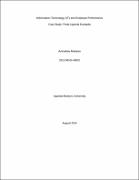Information Technology (IT) and employee performance case study: Posta Uganda Kampala
Abstract
The study was aimed at finding out the effect of information technology on employee performance of Posta Uganda. The three specific objectives were; To find out the effect of IT on volume of work output by employees in Posta Uganda; Secondly to find out the effect of IT on timely work output at Posta Uganda; and thirdly and to find out the effect of IT on service delivery
of employees in Posta Uganda, The study employed a quantitative research model in which a case study research design was used to collect data from 40 respondents using structured questionnaires. The study found out that there
is a strong positive relationship between IT and employee performance in Posta Uganda. The correlation coefficient value was found to be = 0.52, and at sig= 0.000<0.01 for volume of work output. This meant that IT influences volume of work output by more than 52%. The study also found out that there is a strong positive relationship between IT and timely work output in Posta Uganda. The correlation coefficient was found to be 0.734 at sig=000<0.01, meaning that timely work output is influenced by IT by at least 73.4%. Furthermore, the study found out that there is a moderate positive relationship between IT and service delivery in Posta Uganda. The correlation coefficient was found to be 0.49 at sig= 0.000<0.01, meaning service delivery is influenced by IT by 49%. The study concluded that IT has a significant positive influence on the performance of employees in Posta Uganda as measured by the variables of increased volume of work, timely work output and service delivery which were found to be positively influenced by IT. As such, it was recommended that the standard and quality of Information Technology be continuously improved so as not to compromise employee performance and service delivery to the organisation’s clients. The study further recommends that managers and policy makers need to keep abreast of the developments in this dynamic information technology sector to ensure uptodateness because new innovations keep coming up in the field of IT as old technologies become obsolete, thus there is need to maintain current and up-to-date technologies which are more efficient.


